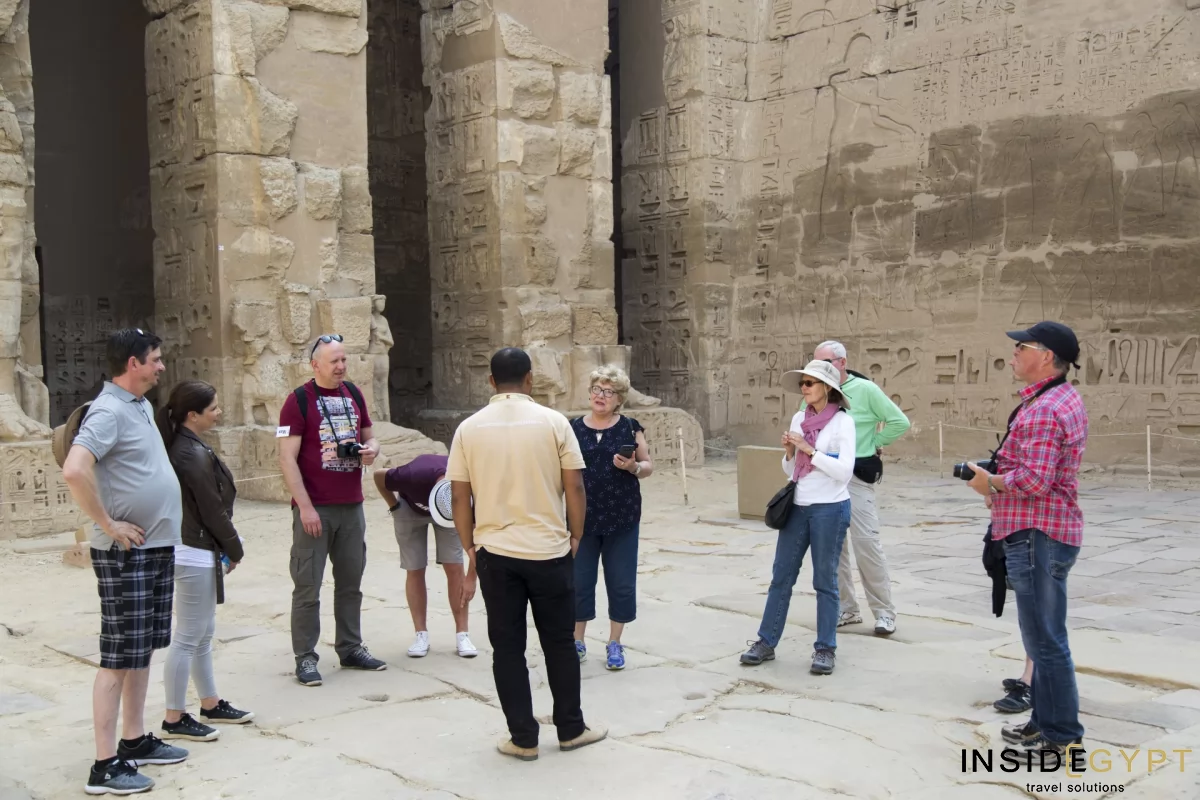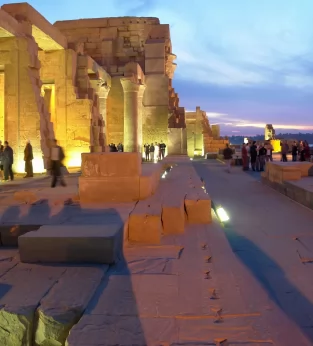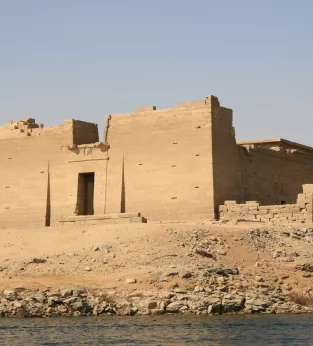Stay updated!
The Temple of Ramses III at Medinet Habu is a must-see historical site in Luxor, celebrated for its architectural grandeur, intricate carvings, and the powerful legacy of ancient Egyptian kingship. This remarkable temple stands as a testament to Ramses III's reign, showcasing impressive reliefs and inscriptions that narrate tales of victory and divine protection.
With the focus on intimate groups and personalized services, these tours ensure a rich, immersive experience led by expert guides who are knowledgeable Egyptologists. They skillfully and passionately bring the history of Habu Temple to life, revealing fascinating stories behind its creation and the life of Ramses III.
A trip to the Temple of Ramses III at Medinet Habu is thoughtfully included in our 14 Days in Egypt Tour package. Additionally, this captivating site can be explored during the optional excursions of our 15-Day Egypt Tour with Siwa Oasis, 12-Day Luxury Dahabiya Nile Cruise, and 10 Day Tour of Egypt.
Join us to experience this stunning temple and uncover the mysteries of ancient Egypt in an unforgettable way.
See this incredible temple and more like it on tailor-made tours! Book your Egypt tour package!
Photos of the Temple of Ramses III and Medinet Habu








Discover Our Exclusive Egypt Tours
Tour Reviews
FAQ About Medinet Habu Temple and Ramses III
What is the Temple of Ramses III, and why is it significant?
The Temple of Ramses III, located in the Medinet Habu at Luxor, is a remarkable testament to ancient Egyptian civilization, embodying both historical and cultural significance. As a major sacred site and a fortified complex, this temple serves as a reflection of the grandeur of Ramses III's rule during the Twentieth Dynasty, showcasing his dedication to safeguarding Egypt's borders and maintaining its power.
Historically, the Medinet Habu Temple complex is known for its impressive architecture, which includes massive walls, intricately carved reliefs, and large courtyards designed for both religious worship and military display. This dual purpose highlights Ramses III's efforts to project strength and divine favor, as he sought to protect Egypt from invasions and economic decline. The temple complex features depictions of significant battles and scenes that celebrate his victories, enhancing its status as a crucial part of Egypt's heritage.
Culturally, the temple remains a masterpiece of ancient Egyptian architecture. The intricate designs and artistic accomplishments found throughout the Temple of Habu illustrate the advanced engineering skills and artistic expression of the time. The layout and decorative motifs resonate with the broader context of ancient Egyptian religious practices and the pharaoh's role as a mediator between the gods and the people.
As part of Luxor's rich historical landscape, the Medinet Habu Temple complex stands out not only for its artistic brilliance but also as a symbol of the enduring legacy of Ramses the 3rd. Visitors to this extraordinary site can appreciate the deep historical narratives embedded within its structures and truly understand its significance in the historical records of ancient Egypt.
Who was Ramses the Third?
Ramses the Third, one of the most significant figures in ancient Egyptian history, is celebrated for his exceptional military prowess and his crucial role in securing Egypt's independence against foreign invaders during a tumultuous period. His reign, which lasted from approximately 1186 to 1155 BCE, marked the final flourishing of Egypt's New Kingdom, establishing him as one of its last great pharaohs.
Ramses III is notably recognized for his successful military campaigns against the Sea Peoples, a confederation of naval raiders that threatened Egypt's borders. His strategic victories not only safeguarded the nation but also reinforced his position as a powerful leader. The famous battle reliefs vividly depict these engagements, illustrating the pharaoh's prowess and the divine favor he believed guided him in battle.
In addition to his military achievements, Ramses III focused on monumental construction projects, most prominently the grand funerary temple located in the Theban necropolis. This temple was designed to honor both his legacy and the gods, featuring detailed carvings and inscriptions that celebrated his accomplishments and ensured his memory would be preserved for future generations.
Ramses III face, often depicted in statues and reliefs, exhibits the powerful and divine nature attributed to pharaohs, solidifying his status in the eyes of the Egyptian people. His reign is remembered not only for its military significance but also for the cultural and architectural advancements that emphasized the enduring glory of ancient Egypt.
Where is the Temple of Ramses III located?
The Temple of Ramses III is located within the Medinet Habu complex on the West Bank of the River Nile, near the foot of the Theban Hills, opposite the modern city of Luxor, Egypt. This archaeological locality is renowned for its significance and is closely associated with the Mortuary Temple of Ramses III, which is considered one of the largest and best-preserved sites in the area.
This complex is part of the Theban Necropolis, an area rich in archaeological importance, featuring numerous temples and tombs from the ancient Egyptian civilization. The complex itself was historically an inhabited settlement, which thrived since pharaonic times and continued to exist as a Coptic center until the 9th century. Excavations conducted in the late 19th century revealed fascinating insights into the structure and remnants of this ancient town.
To reach the temple, there are various transportation options available from central Luxor. Visitors can take a taxi or arrange a private car for convenience, with the journey typically taking about 20-30 minutes. There are also opportunities for guided tours that include the temple as part of a larger exploration of the Theban Necropolis, providing a deeper insight into this significant archaeological area.
Exploring the temple not only offers a glimpse into the grandeur of ancient Egypt but also places visitors in a historically rich context within the Theban Necropolis, making it a must-visit site for anyone traveling to Luxor.
How is Ramses’ Temple connected to Medinet Habu?
The Ramses III is intricately connected to the broader Medinet Habu complex, which serves as both a religious and military structure, reflecting the dual nature of Ramses III's reign. Located in Western Thebes, the complex not only includes the impressive mortuary but also features remnants of earlier structures, such as the temple of Thutmose III and the administrative palace associated with the pharaoh.
Upon entering, visitors are greeted by a courtyard surrounded by majestic pillars that depict Ramses III in the form of Osiris, emphasizing its religious significance. Beyond the first courtyard lies a second courtyard that leads to a hypostyle hall, where statues of Ramses III alongside the god Thoth celebrate the connection between the divine and the pharaoh. This structure represents not only a place of worship but also the embodiment of Ramses' power and divinity.
Additionally, the temple is adorned with intricate reliefs that showcase battle themes, particularly celebrating Ramses III's victories over the Libyans and the Sea Peoples. These depictions serve to reinforce his military capabilities and victory celebrations, further highlighting the temple's role as a space for both homage to the gods and a commemoration of military triumph.
The broader Medinet Habu complex reflects a fortified structure, reminiscent of Canaanite fortresses, with defensive walls that historically encircled the area. This strategic design underscores its function as a safe haven and administrative center during Ramses III's rule. While the residential palace of Ramses III has largely been destroyed, the few surviving scenes within the ruins indicate the importance of the king's domestic and ceremonial life.
In later periods, the area continued to hold significance as the town of Jeme, which developed into an important Coptic religious center, demonstrating the lasting legacy of the Medinet Habu Temple complex throughout history. Overall, the relationship between the temple and the surrounding complex embodies the profound intersection of religious devotion and military achievement, making it a pivotal site in understanding ancient Egyptian culture and history.
What else is there to see and do in Medinet Habu and Luxor?
When visiting Medinet Habu and the surrounding Luxor area, there are numerous attractions to explore, making it easy to create a complete and memorable itinerary. Here are some must-see sites:
Valley of the Kings
Just a short drive from Medinet Habu, this famous burial site is home to the tombs of numerous pharaohs, including the famous tomb of Tutankhamun. Visitors can examine the exquisite wall paintings and hieroglyphs within the tombs and learn about the ancient burial practices of the New Kingdom.
Temple of Hatshepsut (Deir el-Bahari)
Located nearby to Medinet Habu at Luxor, this stunning mortuary temple dedicated to Queen Hatshepsut is an architectural marvel. Its terraced structure features impressive colonnades and reliefs that narrate the queen's life and achievements, offering visitors insight into her reign and the role of women in ancient Egypt.
Colossi of Memnon
These two massive statues of Pharaoh Amenhotep III stand at the entrance of his mortuary temple and are iconic symbols of ancient Luxor. Surrounded by beautiful desert landscapes, they provide a perfect photo opportunity and a chance to appreciate the grandeur of ancient Egyptian sculpture.
These attractions offer visitors a deeper understanding of ancient Egyptian civilization and are easily accessible from Medinet Habu.
Are there guided tours available at the Temple of Ramses III and Medinet Habu?
Guided tours are available at the Temple of Ramses III and Medinet Habu, offering an enriching experience that brings this magnificent site to life. Inside Egypt provides exclusive, in-depth tours that delve into the rich historical context and cultural insights surrounding the temple.
Why Choose Inside Egypt's Guided Tours?
Our knowledgeable guides are passionate Egyptologists who provide invaluable context about the temple's art, architecture, and historical significance. They illuminate the stories represented in the intricate carvings and reliefs, enhancing your understanding of the legacy of Ramses the third.
With an expert leading the way, you'll gain a deeper appreciation of the rich narratives and monumental achievements of ancient Egyptian civilization.
Experience more than just the sites; our guides offer insights into the living culture, traditions, and beliefs that continue to influence modern Egypt.
Tour Packages Featuring Medinet Habu:
14 Days in Egypt Tour Package
This comprehensive itinerary includes a visit to the Temple of Ramses III, allowing you to explore its grandeur as part of a diverse selection of historically significant sites.
Optional Excursions:
The Temple of Ramses III can also be visited during the optional excursions of our:
15-Day Egypt Tour with Siwa Oasis
12-Day Dahabiya Cruise
10-Day Tour of Egypt
Embark on a journey with Inside Egypt with our expert guide, ensuring a memorable and insightful exploration of this iconic monument.
Discover Our Exclusive Egypt Tours
At Inside Egypt, we pride ourselves on offering unique and memorable travel experiences. Our trips are expertly designed and led by knowledgeable guides who are Egyptologists, ensuring that you gain a deep understanding of Egypt's rich history and vibrant culture.
Why Choose Inside Egypt?
Expert Guidance: Our experienced guides bring the ancient world to life.
Cultural Immersion: Experience the essence of Egypt, both past and present.
Adventure and Camaraderie: Journey with like-minded travelers and form lasting friendships.
Explore Our Egypt Vacation Packages:
- 17 Days in Egypt on a Nile Cruise: A leisurely journey exploring ancient sites along the iconic Nile River.
- 15-Day Egypt Tour with Siwa Oasis: Discover the unique landscapes and cultural gems of Siwa Oasis alongside historical landmarks.
- 14 Days in Egypt Tour: A comprehensive exploration of Egypt's most significant sites and hidden treasures.
- 12-Day Egypt & Dahabiya Cruise: A stylish, slow-paced sail on a traditional dahabiya, combining Nile-side temples with relaxed moments on the river.
- 10-Day Tour of Egypt: An ideal option for those looking to hit the highlights in a shorter time frame.
- 8-Day Egypt Tour: Perfect for a quick yet in-depth experience of Egypt's highlights.
Join us at Inside Egypt and embark on an extraordinary adventure that blends exploration, education, and cultural appreciation!
What People Have to Say About Our Medinet Habu Tours at Luxor
This lesser-known gem offers an intimate experience with its captivating carvings and vibrant colors, making it a must-see destination for those exploring Luxor.
"This temple complex should definitely be on your list if you're visiting Luxor. The intricate carvings and vibrant colors create a breathtaking atmosphere that's filled with history. With fewer crowds compared to the more famous sites like Luxor and Karnak temples, you can truly immerse yourself in exploration here." Mary Brown
"While the Karnak and Luxor temples are undeniably grand, Medinet Habu stands out as an unparalleled experience. The profound detail of the wall carvings and the radiant colors will leave you in awe. Plus, exploring the additional structures on the grounds, including rooms from the pharaoh's palace, adds to the allure and sense of wonder." Kervie Fernandez
"Don't miss the chance to visit this remarkable temple! It was easily the highlight of our trip. The vibrant colors contrast dramatically with time's wear, creating a stunning visual impact. With its tranquil atmosphere and fewer visitors, Medinet Habu truly captivated me and became my favorite site in Luxor." Patty Drew
Other Sites Nearby
Near the Temple of Ramses III and Medinet Habu, several notable tourist attractions provide insight into ancient Egyptian history and culture:
Hatshepsut Temple (Deir el-Bahari): Located a short distance from Medinet Habu, this stunning mortuary temple honors Queen Hatshepsut and is renowned for its unique architecture and impressive colonnades.
Valley of the Kings: Just a short drive away, this famous burial site features the tombs of many pharaohs, including Tutankhamun. Visitors can explore the richly decorated tombs and learn about ancient burial practices.
Colossi of Memnon: These two massive stone statues of Pharaoh Amenhotep III stand at the entrance of his mortuary temple and are noteworthy for their grandeur and historical significance.
Mortuary Temple of Ramses II: Also nearby, this temple complex showcases the grandeur of Ramses II's reign, featuring monumental statues and impressive wall reliefs that depict his military victories.
Valley of the Queens: Located close to the Valley of the Kings, this site contains the tombs of royal family members, including the burial sites of some of the queens of the New Kingdom.
Luxor Temple: Located in the heart of Luxor, this impressive temple complex is known for its stunning architecture and historical significance. It was built to honor the god Amun and is renowned for its massive statues, obelisks, and vibrant reliefs.
Karnak Temple: Just a short distance from Luxor Temple, this sprawling temple complex is one of the largest religious sites in the world. Visitors can explore its vast halls, towering columns, and sacred lakes, gaining a deeper understanding of ancient Egyptian worship and daily life.










